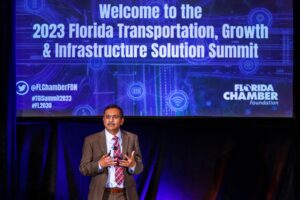Infrastructure’s Role in Fueling Florida’s Economic Growth
By: Ananth Prasad, President, Florida Transportation Builders’ Association and Florida Chamber Infrastructure Coalition Chair
Florida has long been a beacon of opportunity, attracting businesses, tourists, and residents alike. Its remarkable growth and economic success can be attributed, in part, to its world-class infrastructure. However, as Florida experiences unprecedented growth in population and community needs, it is essential that we ramp up our efforts to prioritize preparing Florida’s infrastructure for continued smart growth and development.
Addressing Population Growth:
Florida is currently the third most populous state in the U.S. and is projected to grow to almost 26 million residents by 2030, placing strain on the existing infrastructure. To accommodate this growth, strategic planning and investment in transportation, utilities, and public services are essential. The Florida 2030 Blueprint emphasizes the need for expanded public transit systems, improved road networks, and upgraded utilities to meet the demands of a rapidly growing population.
Economic Growth and Job Creation:
Investing in infrastructure has a direct correlation with economic growth and job creation. Currently, Florida creates 1 in every 11 jobs in the nation and welcomes $4.48 million per hour in income migration. By expanding and improving transportation networks, such as highways, railways, seaports, and airports, Florida can continue to attract businesses and talent, facilitate trade, and stimulate economic activity, leading to increased employment opportunities and enhanced productivity.
Enhancing Connectivity and Trade:
Florida’s geographic advantage as a gateway to the Americas presents immense opportunities for trade. The Florida Trade & Logistics 2030 Study reveals that the trade, logistics, and distribution sectors represent approximately 10 percent of Florida’s GDP and accounted for over 650,000 jobs in Florida in 2020. Additionally, goods moving in or out of the country by way of Florida customs were valued at $179.5 billion in 2022. By investing in port infrastructure, rail networks, and intermodal facilities, Florida can better accommodate the growing demands of global trade, attract new businesses, create more job opportunities, and solidify its position as a vital hub for international commerce.
Tourism and Hospitality:
Florida’s tourism industry, a major driver of the state’s economy, heavily relies on efficient infrastructure. According to The Florida Scorecard, Florida currently ranks #1 in the nation for overseas visitors and set a record high of 137.6 million total visitors in 2022. By investing in road improvements, public transit, and sea and airport expansions, Florida can enhance visitors’ experiences, reduce congestion, and ensure the ongoing success of its tourism and hospitality sectors.
Resilience and Sustainability:
Florida’s unique geography also exposes it to natural disasters, making resilient infrastructure a necessity. According to the Florida Trade & Logistics 2030 Study, Florida experienced 27 “billion-dollar” disasters between 2010 and 2021. With 1,350 miles of coastline, over a third of the world’s insured hurricane risk is in Florida. By strengthening infrastructure resilience through measures such as building codes, flood mitigation systems, and infrastructure hardening, Florida can reduce devastation, protect lives and livelihoods, and maintain business continuity. The Florida Chamber and its partners will be diving further into this topic at the Florida Chamber Annual Insurance Summit, December 14-15 in Orlando.
Bridging the Rural-Urban Divide:
While urban areas in Florida continue to flourish, rural communities often face disparities in their infrastructure. Florida’s rural areas account for 85 percent of Florida’s land area, yet less than 10 percent of the population resides in rural communities. The Florida 2030 Blueprint emphasizes the importance of bridging this divide by investing in rural infrastructure, including private broadband connectivity, improved transportation links, and access to quality healthcare and education. Prioritizing development across Florida ensures both access and opportunity can stimulate economic diversification and enhance overall prosperity in the state.
Leveraging Technology and Innovation:
Embracing technology and innovation in infrastructure planning and development can yield substantial economic benefits. For example, Florida’s information technology sector has grown the most over the past four years, leading the state in per-worker GDP at $422 thousand. By integrating intelligent transportation systems, smart grids, and digital connectivity into Florida’s strategic tech and innovation approach, Florida can enhance efficiency, reduce congestion and energy consumption, attract businesses and talent, and foster competitiveness and innovation-driven economic growth.
Florida’s infrastructure serves as a catalyst for economic success, enhanced quality of life, and positions Florida as a global leader in innovation and resilience. By focusing on the Florida 2030 Blueprint’s infrastructure goals and the strategic recommendations of the Florida Trade & Logistics 2030 Study, Florida’s business community and policymakers have the opportunity to significantly influence a well-planned infrastructure network in Florida that will propel our economy to the global top 10 and ensure our communities are able to support the continued growth.
The Florida Chamber’s Infrastructure Coalition is focused on creating long-term investments in Florida’s infrastructure to maximize Florida’s economic growth. As the Infrastructure Coalition Chair, I invite you to learn more about the Coalition HERE> and join me at the virtual 2023 Florida Transportation, Growth & Infrastructure Solution Summit on December 7 from 1:00pm-4:00pm ET as we dive into these important infrastructure topics and more. If you are unable to watch the live summit, it can be viewed up to two weeks post-event.
